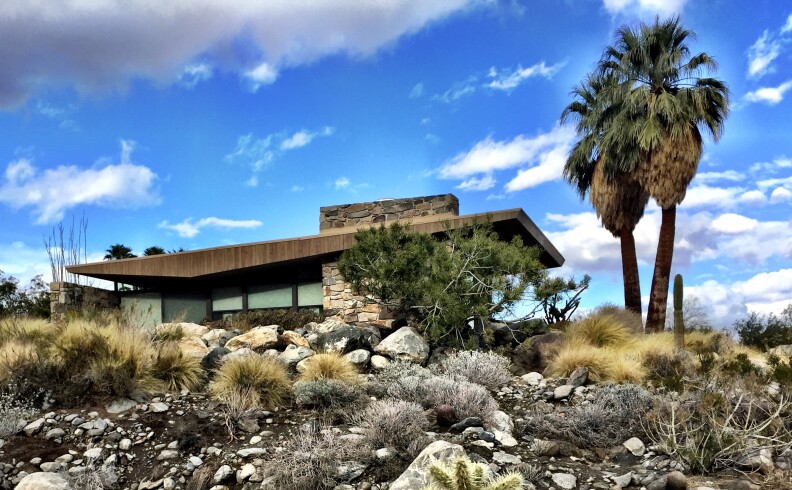What sits in the desert, is over 60 years old, and is full of sharp corners?
If you answered "modern architecture," you're right, and you'd fit right in at Modernism Week, which starts February 11 in Palm Springs.
There you'll find tens of thousands of architecture fans discussing the works of Frank Lloyd Wright, Albert Frey, Richard Neutra and others that make up many of the homes and businesses of Palm Springs. According to organizers, last year's Modernism Week attracted almost 60,000 people and brought in $22 million to the local economy. And if this year's event is like those before it, the numbers will be even bigger.
If you do go, Peter Moruzzi says there will be lots to do. Moruzzi is an historic preservationist who founded the Palm Springs Modern Committee in 1998 and is author of "Palm Spring Holiday."

He's not officially connected with Modernism Week, although the home he shares with his husband will be on a house tour. "Every day there are bus tours... parties every night at a different house or some other location," Moruzzi says. "There are lectures, film premieres. There's so much."
But before the crowds get there, it's worth asking - how did all those modern buildings end up in Palm Springs?
To find the answer, follow the money.
"Back in the day, lots of movie stars and wealthy people went to Palm Springs, because that was the place to go in the winter time, and they started doing that in the 1920s. So there was always money in Palm Springs," Moruzzi explains.
The post-war affluence of the 1940s brought even more money to the desert city, as the newly-minted middle class began moving to the desert city. And of course, there was room to build.
"After World War 2, modernism took over. So the banks, city hall - almost every building you can think of that was popping up at that time was modern," Moruzzi says.

Palm Springs' growth in the 1940s - combined with with its celebrity-backed architects - is key to understanding its modern architecture today.
"It was the style after World War 2. It was considered to be sophisticated, contemporary, it's what people wanted to be associated with if you wanted to be 'of the moment,'" Moruzzi says. "Modern commercial buildings, modern residential, modern everything."
Just as they had grown together, once modernism fell out of fashion, Palm Springs did too.
"In the late '70s and into the '80s, attention started moving east, what they call Down Valley - Rancho Mirage, La Quinta, Palm Desert, Indian Wells," Moruzzi says. "They started building more golf courses and gated communities, and Palm Springs was no longer the place to be. Because of that, most of the great architecture survived."
As for its renaissance, Palm Springs modernism has the '90s and gay people to thank.
"Gay people started moving [there] in the '80s because it was a great environment, there was nobody to bother you," Moruzzi explains. "Then there was a transition - starting in the 90s, when modernism was being rediscovered, a lot of gay people came from all over the world and were a part of the preservation movement."
At this year's Modernism Week, there will be one more modern icon to add to the tour - The Salton Sea Yacht Club, which was built in 1958 by Albert Frey, and saved from extinction with Moruzzi's help.

"[Frey] was commissioned to build this amazing nautical-style yacht club on the edge of the Salton Sea," Moruzzi says. But when tourism, and much of the water, at the Salton Sea dried up, the yacht club was abandoned.
"It was almost demolished. But the county of Riverside took the initiative and actually restored it to its original look - and it's beautiful," Moruzzi says. "So, I wrote a National Register nomination for the property, which was accepted, so we're having a big celebration on Friday, February 12 to unveil the plaque and learn about the Salton Sea - it's going to be a lot of fun."




